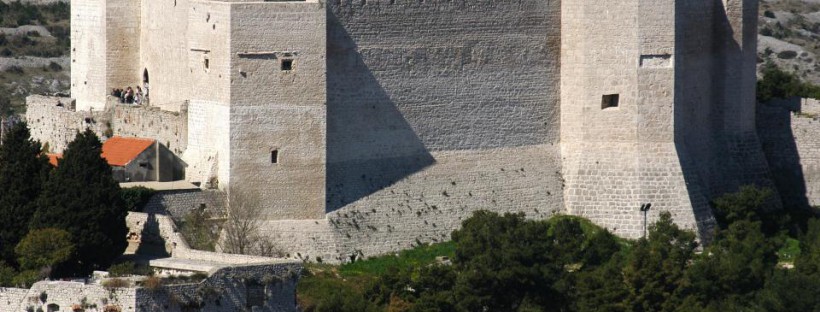Medieval St. Michael’s Fort is a must-see destination for every visitor of Šibenik.
This imposing fortification was erected on a sixty metre high steep rock hill and is one of the city of Šibenik’s main symbols. The oldest originally Croatian city on the Adriatic coast, first mentioned on Christmas of 1066 as a place visited by Croatian King Petar Krešimir IV, sprung behind its walls.
The fortress was named after St. Michael’s Church, built within its walls in the 12th century. The church was not preserved; however, the fortress still bears the name of Šibenik’s patron saint. The importance of this site in the Šibenik region’s history is evidenced by numerous archaeological findings – prehistoric axes, bone needles from Roman times and medieval ceramics – which today form an important part of the Šibenik City Museum’s collection.
The fort was originally built as an observation post of the entire bay and the mouth of the Krka River, but also as a shelter for people of Šibenik and the surrounding area. In medieval times, it assumed a key role as a fortification system consisting of town walls and forts. Since it was a key defence position in the region, the fort was destroyed and subsequently restored several times in its history and has been preserved to this day in form of an irregular rectangle. After being restored for two years, from June of 2014, with EU funds, it is now open to visitors daily.
A unique stage
Apart from the restored perimetral walls and cellars, St. Michael’s Fort also got a unique summer stage with a panoramic view of the archipelago. Its beauty and uniqueness is also evidenced by thrilled performers, great stars of both local and foreign music scenes, and numerous members of the audience. Each evening programme revitalises synergy between this beautiful ambience and all types of performers – rock stars, pop stars, jazz musicians or symphony orchestras. Inside the walls, immersed into the lustre of Šibenik’s rich history, stands the most beautiful open-air stage which has in its first season already hosted some of the most renowned local and international artists, becoming a leading concert venue in Dalmatia. The only thing that might surpass the unforgettable experience of top musical and theatrical events under the starry sky is the newly discovered beauty of historical heritage, beautifully restoring the spirit of the past.
The B Side, the latest artistic programme organised by the Fort, brings famous music, dance and performing arts names. The other side of this beautiful summer stage is smaller – a stone stage with an amphitheatre for audience. Numerous tourists also enjoy the intimate, club atmosphere of this magical cultural heritage site aimed at fans of all art forms. This season, the fort will also organise an art programme in cooperation with the Academic painter and graphic artist Zvonimir Vila.
Medieval prints making process
This is a joint cooperation of artistic, educational, workshop and exhibition character, named after one of the greatest chalcographers of High Renaissance and Mannerism in Europe, Martin Kolunić Roti from Šibenik (Šibenik, around 1532 – Vienna, 1582 or 1583). The grandeur of his Šibenik inspired the cooperation named Homage to Martin Kolunić Rota.
– There could be no better surroundings than St. Michael’s Fort to demonstrate the strength of traditional, medieval graphics techniques in their original form. Zvonimir Vila, a master of graphic art and craft owns an original manual press for intaglio printing and many tools used once upon a time by one of Europe’s greatest chalcographers, Martin Kolunić Rota from Šibenik. Visitors will get a unique opportunity to see and learn about some of the forgotten medieval processes of print making – said Gorana Barišić Bačelić, Šibenik Fort Manager.
THE 13TH CENTURY EASTERN WALL
The oldest part of the fort preserved to this day, the eastern wall, dates from the 13th century; however, the biggest part of the fort, such as the remaining walls, halls and double defensive walls – was built in the 15th century. Significant damage to the walls occurred in 1663 and 1752 when the gunpowder plant located inside the fort exploded. Water access, which is essential for military purposes, was secured by constructing two cisterns, preserved to this day. Other supporting structures, such as dormitories, warehouses and other important areas, have not been preserved. Attractive double defensive walls, leading down a steep cliff to the sea, are also a part of the fortification complex. They were used for withdrawal of army troops or transporting supplies to the troops in case of enemy siege or citizens’ rebellion.




